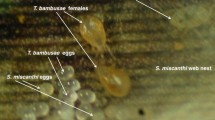Summary
The adaptive significance of sibling cannibalism was analyzed in the ladybird beetleHarmonia axyridis at two prey densities. Possible costs and benefits were considered from three points of view: the mother, the cannibal and the victim. Cannibals ate both infertile and fertile eggs, thereby increasing in body length and survival rate with the intensity of sibling cannibalism. The cannibalistic trait was clearly beneficial to the cannibal when aphid density was low. However, it was not always beneficial when aphid density was high and the victims were full siblings. The altruistic behavior of being a victim was beneficial only when the victim was cannibalized by full siblings at low aphid density. The mother attained almost equal fitness at low aphid density, regardless of the intensity of sibling cannibalism. This suggests that sibling cannibalism is not maladaptive for the mother. At high aphid density, however, mother’s fitness decreased with the intensity of sibling cannibalism, indicating that sibling cannibalism is maladaptive for the mother when larval food availability is high.
Similar content being viewed by others
References
Banks, C. J. (1955) An ecological study of coccinellidae (Col.) associated withAphis fabae Scop. onVicia faba.Bull. Entomol. Res. 46: 561–587.
Banks, C. J. (1956) Observations on the behaviour and mortality in coccinellidae before dispersal from the egg shells.Proc. Roy. Entomol. Soc. Lond. (A) 31: 56–60.
Banks, C. J. (1957) The behaviour of individual coccinellid larvae on plants.Brit. J. Anim. Behav. 5: 12–24.
Baur, B. and A. Baur (1986) Proximate factors influencing egg cannibalism in the land snailArianta arbustorum (Pulmonata, Helicidae).Oecologia 70: 283–287.
Brown, H. D. (1972) The behaviour of newly hatched coccinellid larvae (Coleoptera: Coccinellidae).J. Entomol. Soc. S. Afr. 35: 149–157.
Dixon, A. F. G. (1959) An experimental study of the searching behaviour of the predatory coccinellid beetleAdalia decempunctata (L.).J. Anim. Ecol. 28: 259–281.
Dixon, A. F. G. (1970) Factors limiting the effectiveness of the coccinellid beetleAdalia bipunctata (L.), as a predator of the sycamore aphid,Drepanosiphum platanoides (Shcr.).J. Anim. Ecol. 39: 739–751.
Dixon, A. F. G. (1971) The role of intra-specific mechanisms and predation in regulating the numbers of the lime aphid,Eucallipterus tiliae L.Oecologia 8: 170–193.
Eickwort, K. R. (1973) Cannibalism and kin selection inLabidomera clivicollis (Coleoptera: Chrysomelidae).Am. Nat. 107: 452–453.
Evans, E. W. and A. F. G. Dixon (1986) Cues for oviposition by ladybird beetles (Coccinellidae): response to aphids.J. Anim. Ecol. 55: 1027–1034.
Fox, L. R. (1975) Cannibalism in natural populations.Ann. Rev. Ecol. Syst. 6: 87–106.
Hamilton, W. D. (1964a) The genetical evolution of social behaviour. I.J. Theor. Biol. 7: 1–16.
Hamilton, W. D. (1964b) The genetical evolution of social behaviour. II.J. Theor. Biol. 7: 17–52.
Kawai, A. (1978) Sibling cannibalism in the first instar larvae ofHarmonia axyridis Pallas (Coleoptera; Coccinellidae).Kontyû 46: 14–19.
Maynard-Smith, J. (1982)Evolution and theory of games. Cambridge University Press, Cambridge.
O’Connor, R. J. (1978) Brood reduction in birds: selection for fratricide, infanticide and suicide?Anim. Behav. 26: 79–96.
Osawa, N. (1989) Sibling and non-sibling cannibalism by larvae of a lady beetleHarmonia axyridis Pallas (Coleoptera; Coccinellidae) in the field.Res. Popul. Ecol. 31: 153–160.
Osawa, N. (1991a)Ecological Studies on the Ladybird Beetle Harmonia axyridis Pallas in a Natural Population. Ph. D. Thesis, Kyoto Univ. (in Japanese).
Osawa, N. (1991b) Consequences of sibling cannibalism on fitness of mother and offspring of the ladybird beetleHarmonia axyridis. 221–225. In L. Polgár, J. R. Chambers, A. F. G. Dixon and I. Hodek (eds)Behaviour and Impact of Aphidophaga. SPB Academic Publishing bv, The Hague.
Polis, G. A. (1980) The effect of cannibalism on the demography and activity of a natural population of desert scorpions.Behav. Ecol. Sociobiol. 7: 25–35.
Polis, G. A. (1981) The evolution and dynamics of intraspecific predation.Ann. Rev. Ecol. Syst. 12: 225–251.
Stearns, S. C. (1977) The evolution of life history traits: A critique of the theory and a review of the data.Ann. Rev. Ecol. Syst. 8: 145–171.
Wratten, S. D. (1973) The effectiveness of the coccinellid beetle,Adalia bipunctata (L.), as a predator of the lime aphid,Eucallipterus tiliae L.J. Anim. Ecol. 42: 785–802.
Author information
Authors and Affiliations
Rights and permissions
About this article
Cite this article
Osawa, N. Sibling cannibalism in the ladybird beetleHarmonia axyridis: Fitness consequences for mother and offspring. Res Popul Ecol 34, 45–55 (1992). https://doi.org/10.1007/BF02513521
Issue Date:
DOI: https://doi.org/10.1007/BF02513521




